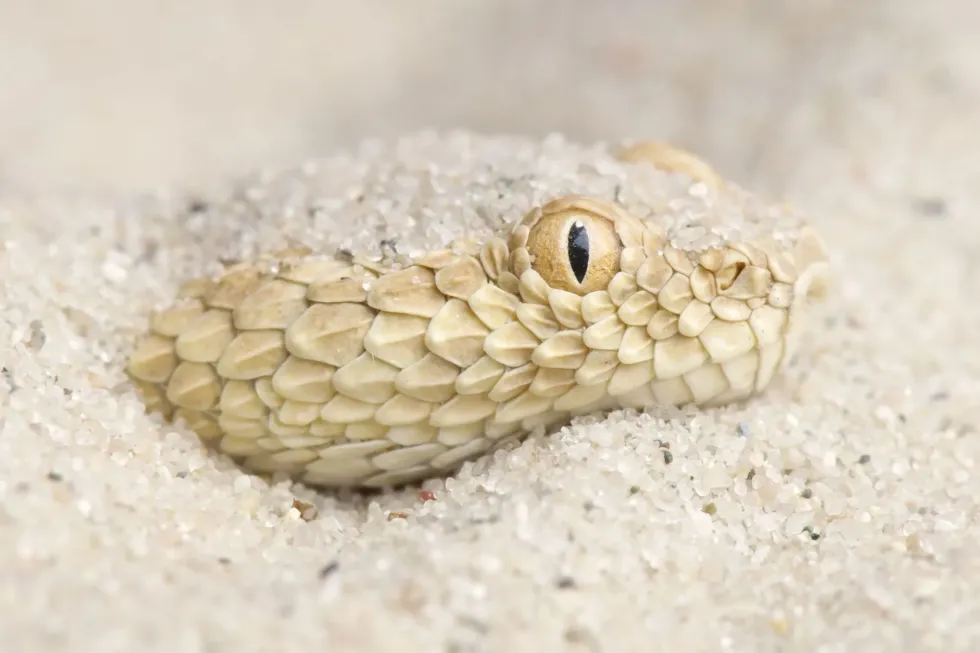The Saharan sand viper (Cerastes vipera) is an Old World snake found in the desert of North Africa, Sudan, Egypt, the Arabian peninsula, and Israel. Their classification is Viperidae family, Squamata order Caerstes genus, Vipera species, and Reptilia class. They are poisonous ambush predators that prey on lizards, geckos, and small mammals.
Their body is buff-colored and tan-colored, which helps them camouflage into the sand. The females are slightly longer than the males.
They are oviparous and reproduce by laying eggs under rocks and in burrows. They are solitary nocturnal animals that are active in the nighttime. They are listed as Least Concern in the Red List.
If you like reading about sand vipers, check out more interesting facts about the scarlet snake and rubber boa!
Sand Viper Interesting Facts
What type of animal is a sand viper?
The Saharan sand viper is a snake of the Cordata Phylum and Squamata Order.
What class of animal does a sand viper belong to?
Saharan sand vipers are venomous snakes. Its family, genus, species, and class classification are Viperidae, Cerastes, Vipera, and Reptilia, respectively.
How many sand vipers are there in the world?
The exact population size of these snakes is unknown. According to their conservation status, there are more than 10,000 mature individuals globally.
Where does a sand viper live?
The Saharan sand viper distribution range includes the Sahara desert, Northern Africa, Egypt, Sudan, and Isreal. Similar viper species like horned viper sand snakes of the same genus are found in the Middle East and Arabian Peninsula.
What is a sand viper's habitat?
The Saharan sand viper snake habitat is arid areas with sand and rock formation like a desert or semi-desert. They don't need a lot of vegetation in the deserts.
Who do sand vipers live with?
Sand vipers are solitary and nocturnal animals. They are only seen in pairs during the breeding season in Africa. They are solitary while hunting in the deserts too.
How long does a sand viper live?
The exact life span of a Saharan sand viper is unknown, but the life span of a close relative, the horned viper, is 15-18 years.
How do they reproduce?
They reproduce by laying eggs. Very little information is available on the mating habits of a Saharan sand viper. The horned viper, from the same genus, mates in April.
They are oviparous; females lay eggs under rocks and in abandoned burrows. The hatchlings measure 4.7-5.9 in (12-15 cm) in length and do not require parental care. Hatchling attains sexual maturity after two years.
What is their conservation status?
The Saharan sand viper (Cerastes vipera) is listed as Least Concern in the IUCN Red List.
Sand Viper Fun Facts
What do sand vipers look like?
The Saharan sand viper (Cerastes vipera) has a buff-colored scaled body that easily camouflages into the sand of the desert. Its body has circular light brown patches.
The males are short, and the females are longer. They lack the distinct short horns above their eyes which are a distinctive feature of the Saharan horned viper (Cerastes cerastes). It is a venomous snake that has fangs holding potent venom.
Its size and body shape are small and stout with a broad, triangular head, like most venomous snakes. This shape is due to the location of the glands which contain venom. They have small eyes.
Their bellies are white, and the tail may or may not have a black tip. Horned vipers also have a black tip on their tail.
How cute are they?
The Saharan sand viper is very attractive due to its textured buff-colored scales, but don't be fooled; they are equally cute and dangerous.
How do they communicate?
Like most snakes, they make a distinctive hissing sound. Saharan sand viper snakes are calm, but if they perceive a threat, they hiss and rub their scales together to produce a rasping sound. It also bites humans with venom.
How big is a sand viper?
The sand viper is small compared to other species of snakes. It measures an average of 7.9-13.8 in (20–35 cm) and a maximum of 1.6 ft (50 cm) in length. It is the same size as a horned viper and 10 times smaller than other snake species with venom, like pit vipers.
How fast can a sand viper move?
Sand vipers are not known for their speed. They are ambush predators who press their bodies into the sand, with only their heads and eyes sticking out.
They usually don't need speed to chase after their prey and lie in wait for the prey to come close. They are known to have a swift strike, which helps them bite into the prey without alerting them prematurely.
How much does a sand viper weigh?
The weight of a sand viper is not known, but other viper species usually weigh 15.4-22 lb (7-10 kg). The sand viper snake in Europe is called European viper, and it weighs 1.8-6.3 oz (51-179 g).
What are the male and female names of the species?
There are no distinctive names for the males and females of this species. They are simply referred to as male sand viper or female sand viper.
What would you call a baby sand viper?
The baby of a sand viper is usually called a hatchling as it hatches from eggs. It can also be called juvenile.
What do they eat?
The Saharan sand viper snake diet consists of lizards, geckos, and small mammals. They are usually ambush predators that submerge themselves into the sand adjacent to rocks or vegetation.
When the prey comes close, they strike quickly and capture the animal using their fangs, releasing their venom. In the few weeks, before they hibernate in the winter, they also exercise active hunting to increase their energy intake.
Are they poisonous?
Yes, both the sand viper and horned viper are venomous. Their bites can be dry or wet, depending on whether they choose to release venom. Their bite is not fatal to a human, but the venom acts as an anticoagulant, causes swelling, pain, and cell death.
Would they make a good pet?
No, they would not make good pets. They are poisonous, dangerous, and cannot be tamed. Keeping them at home can be a life hazard for you and others around you.
Did you know...
Pit vipers are ovoviviparous; the eggs fertilize and mature inside the female's body. The live baby snake comes out of them after hatching. The eggshells are removed after the birth is over or during.
Venomous snakes commonly have a triangular head because the venom glands are located behind the eyes. It was later discovered that non-venomous species also evolved to form triangular heads, which are used to fool other predators into believing that they are poisonous and dangerous.
The Vipera ammodytes, or long-nosed viper, is one of the most dangerous snakes of Europe due to the high toxicity of its venom.
What adaptations do sand vipers have?
Saharan sand vipers are nocturnal snakes. They spend their days resting burrowed in the sand, hiding in holes, under rocks, or in abandoned burrows. They typically move about by sidewinding. They press their weight into the sand or soil, leaving whole-body impressions.
The horns of a horned viper can be folded in to be streamlined with their body to increase ease of travel through the sand and burrowing. A horned viper without distinctive horns looks very similar to the sand viper (Cerastes vipera).
Are sand vipers endangered?
No, sand vipers are not endangered. There are more than 10,000 individuals in the world. Their population is not threatened, and they do not have many common predators either.
Here at Kidadl, we have carefully created lots of interesting family-friendly animal facts for everyone to discover! Learn more about some other reptiles from our taipan facts or Anaconda snake facts.
You can even occupy yourself at home by coloring in one of our free printable sand viper coloring pages.









